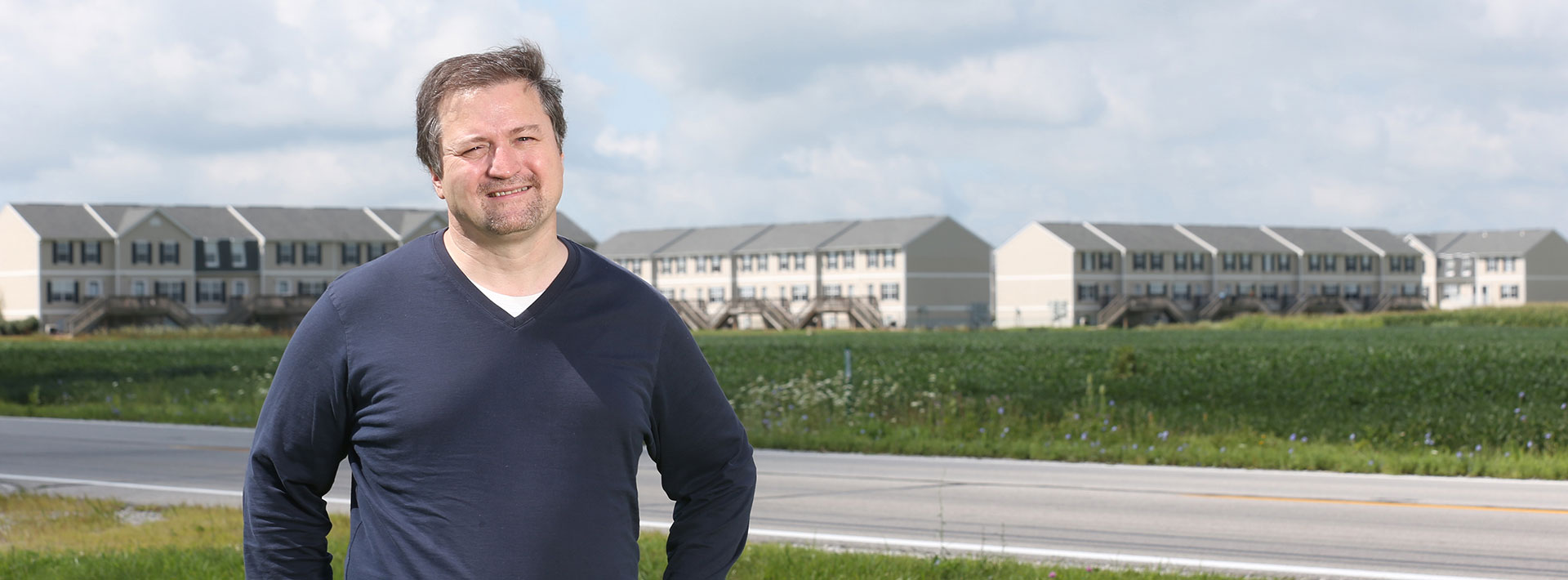Luescher finds fertile ground in northern Sweden

Dr. Andreas Luescher, architecture and environmental design, was away from BGSU for a year on faculty improvement leave, but a list of his publications, collaborations and projects during that time would lead one to think it had been much longer.
Luescher was invited to serve as a guest professor at the School of Architecture at Umeå University, in Sweden. Located in the north of the country, six hours from Stockholm, Umeå is something of a “frontier city,” he said, between the capital and the less settled areas farther north. The deep cold and long nights there turned out to be a fertile climate for thought and productivity for him.
As a faculty member in Umeå, Luescher brought his expertise and experience to a newly created program. Although the university itself is well established, the architecture school has only been in existence for a few years, and programs and personnel are still developing. Classes are taught in English, but the faculty is diverse, with many from Spain. “English was another frontier, language-wise,” he observed.
In addition to teaching classes to a diverse group of architecture and design students, Luescher also had the challenging assignment of teaching pre-med students about giving effective poster presentations. The author of “The Architect’s Guide to Effective Self-Presentation,” he was able to translate his expertise in the topic from architecture to medicine.
Also in that vein, he completed a paper on “The Poster Project,” soon to be published in the Journal of Communication Design: Interdisciplinary and Graphic Design Research.
The Umeå architecture school offers both bachelor’s and master’s degrees. It and the Umeå Institute of Design are located away from main campus in the heart of the town in order to connect better with their environment. “It was stimulating to see what interactions occurred between public and academic occupants,” Luescher said.
The timing was also auspicious as Umeå had been designated the “2014 Cultural Capital of Europe,” which brought an increased focus on art and design.
In celebration of that designation, Luescher co-organized an exhibition with the Vienna (Austria) University of Technology on “The Art of Re-creation: the Changing Culture of Leisure.”
While in Umeå, he completed a book titled “The Design of Frontier Spaces: Control and Ambiguity,” co-edited with Dr. Carolyn Loeb of Michigan State University (see below). And a paper he wrote about a famous Berlin Wall site, “Commemorating the Past and Constructing the Future: Checkpoint Charlie,” has been accepted for presentation at the highly selective International Seminar on Urban Form conference on “City as Organism: New Visions for Urban Life,” to be held in Rome.
He was also able to travel extensively through Europe doing research for his latest book project, “An Explorer’s Guide to European Cultural Sites: Ten Trails Bridging Artistic and Architectural Wonders.”
In addition, Luescher gave several professional workshops and lectures on a variety of topics related to his interests, from designing a portfolio (his first book was “The Architect’s Portfolio: Planning, Design, Production) to “Sustainability and Urban Shrinkage,” a topic with which he has been intensively involved in recent years.
Related to that, he began a new collaboration with Lea Holst Laursen of the Department of Architecture, Design and Media Technology at Aalborg University in Denmark. They are working on a paper called “Towards a New Planning Vocabulary: Developing a Catalogue of Nonconventional Approaches to Steering and Planning Shrinking Territories.” It will be presented at Spaces and Flows: The Sixth International Conference on Urban Studies, at the University of Chicago this October.
Luescher has long engaged his BGSU students with the problem of shrinking cities, using Toledo as a learning lab and looking at ways to reorganize the city’s core. He and his longtime collaborator Dr. Sujata Shetty of the Department of Geography and Planning at the University of Toledo have written extensively on the topic and edited a special issue for Urban Design International titled “Shrinking Cities and Towns: Challenges and Responses.”
“The 2008 crash created new frontiers,” he said. “It changed the city landscape. We have to rededicate the built environment, and find ways to rethink our environment. As faculty it has changed our attitude, to not only teaching about growth but what you do in a non-growth cycle.”
Updated: 12/02/2017 12:48AM
